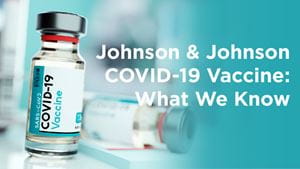
Update April 24, 2021: The United States CDC and FDA reviewed data involving six reported U.S. cases of a rare and severe type of blood clot in individuals after receiving the Johnson & Johnson vaccine. Following a thorough safety review, including two meetings of the CDC’s Advisory Committee on Immunization Practices, the U.S. Food and Drug Administration and the U.S. Centers for Disease Control and Prevention have determined that the recommended pause regarding the use of the Janssen (Johnson & Johnson) COVID-19 Vaccine in the U.S. should be lifted and use of the vaccine should resume.
On April 13, the CDC and FDA released a statement saying the administration of the Johnson and Johnson COVID-19 vaccine would be paused after six recipients got a rare blood clotting disorder.
"The occurrence of this event is very rare - out of 6.8 million doses given out of the Johnson & Johnson vaccine, only six cases have occurred," explained Dr. Ed Walsh, infectious disease specialist at Rochester Regional Health. "All six cases occurred among women between the ages of 18 and 48, and symptoms occurred 6 to 13 days after vaccination."
Clinical trials study large groups of individuals, but not millions--which is why the FDA and the CDC work so hard to closely monitor the population, so they can quickly recognize these occurrences and pause distribution out of an abundance of caution.
"Severe abdominal pain and/or severe, abnormal headache can happen with any new medicine or vaccine," explains Dr. Walsh. "But you should consult your physician if these symptoms continue and/or you are concerned,"
The Johnson & Johnson COVID-19 vaccine is a one-dose injection into a muscle cell. Considered a replication-defective virus vector DNA vaccine, it works by injecting a replication of a defective virus (in this case the common cold) that cannot cause illness. The defective virus is packaged inside replication-defective DNA—which cannot replicate or become part of a person’s DNA – to deliver the virus to your body’s cells.
Once the replication-defective DNA is in the human muscle cell, it enters the nucleus of the muscle cell and the DNA blueprint works to create an mRNA blueprint.
From there, the mRNA leaves the nucleus and, similar to mRNA vaccines like the Moderna and Pfizer/BioNTech COVID-19 vaccines, the mRNA enters a ribosome in the cytoplasm of the muscle cell. Here, the mRNA blueprint is converted to a coronavirus spike protein.
Once the spike protein is created, it moves to the surface of the cell where it sparks an immune response, teaching your body how to recognize and fight COVID-19.
The Johnson & Johnson COVID-19 vaccine is 100% effective in preventing death from COVID-19. The vaccine is 85% effective in preventing severe disease from coronavirus infection and 72% effective in preventing-moderate-to-severe disease, similar to a bad cold.
Unlike mRNA vaccines, the Johnson & Johnson COVID-19 vaccine does not need to be stored in extremely low temperatures. Since it is not an mRNA vaccine, it is more stable and therefore easier to distribute and store.